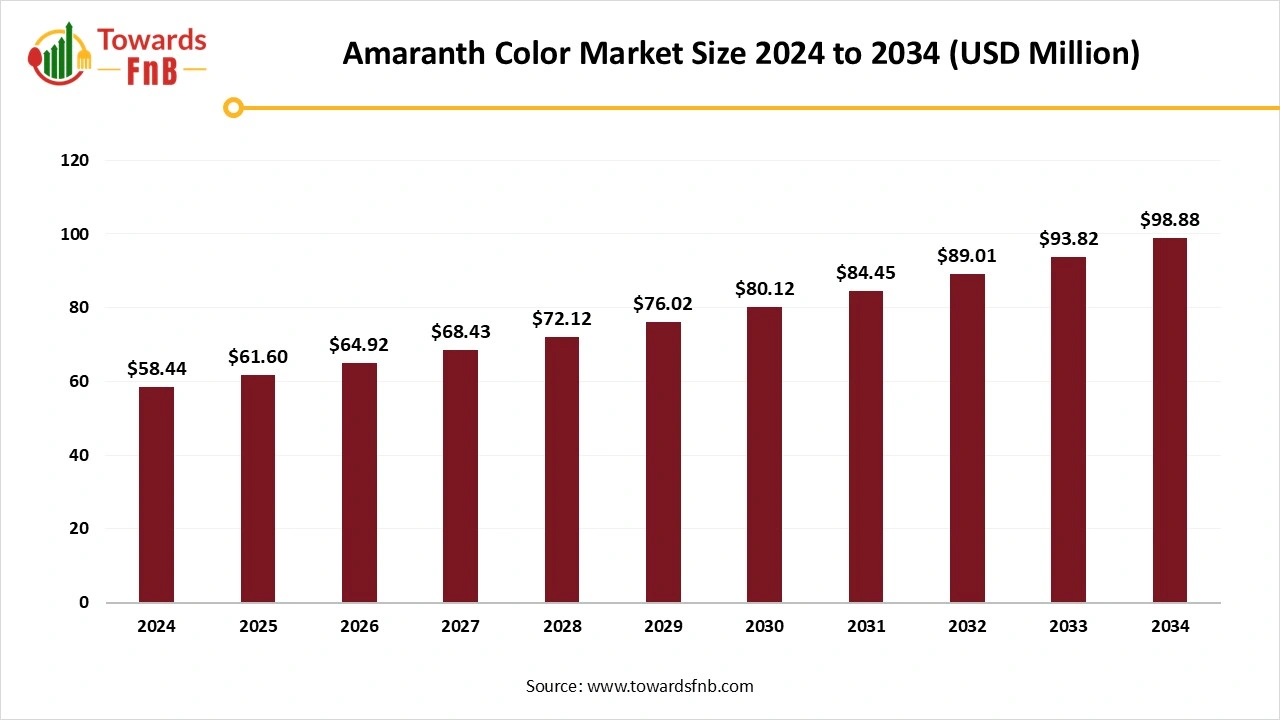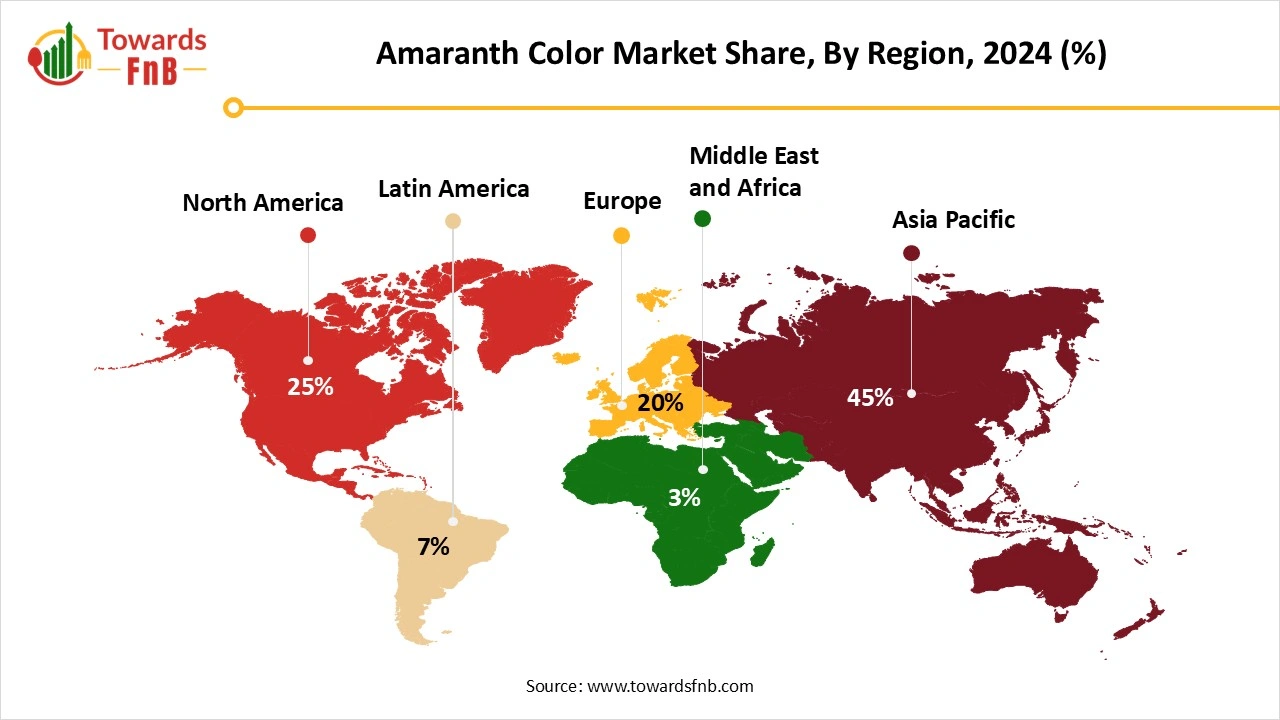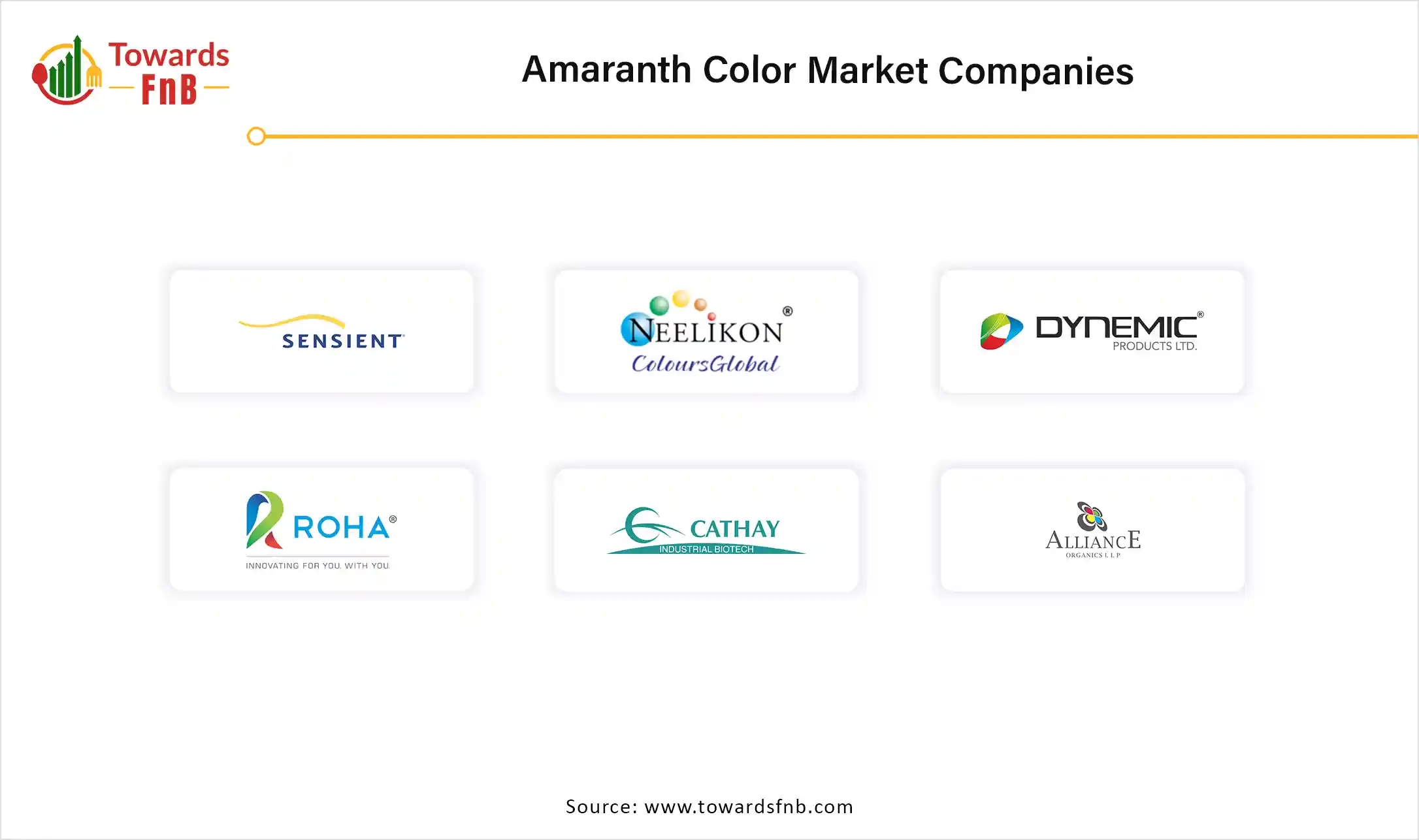October 2025
The global amaranth color market size was reached at USD 58.44 million in 2024 and is anticipated to increase from USD 61.60 million in 2025 to an estimated USD 98.88 million by 2034, witnessing a CAGR of 5.4% during the forecast period from 2025 to 2034. The demand for amaranth is increasing due to the changing lifestyle preferences, which increases the demand for on-the-go food and beverages. The cost-effectiveness of the color also makes it ideal for application in many products.

| Study Coverage | Details |
| Growth Rate from 2025 to 2034 | CAGR of 5.4% |
| Market Size in 2025 | USD 61.60 Million |
| Market Size in 2026 | USD 64.92 Million |
| Market Size by 2034 | USD 98.88 Million |
| Largest Market | Asia Pacific |
| Base Year | 2024 |
| Forecast Period | 2025 to 2034 |
| Regions Covered | North America, Europe, Asia-Pacific, Latin America, and Middle East & Africa |
The amaranth color market refers to the global market for amaranth, a synthetic azo dye (also known as E123) used in food, beverages, cosmetics, and pharmaceuticals for imparting a reddish-purple hue. Despite regulatory restrictions in certain countries (e.g., the U.S.), it remains in demand in others, especially in Asia-Pacific and the Middle East. The market involves natural and synthetic alternatives, driven by trends in food aesthetics, regulatory shifts, and consumer preferences toward clean-label ingredients.
The rapidly increasing demand for processed and packaged foods is one of the major drivers that is gaining popularity due to the changing dietary preferences, mainly in developing regions. In fiscal year 2024, India's exports of processed foods, including products like mango pulp, processed vegetables, processed fruits, juices, and nuts, reached significant levels, totaling hundreds of millions of USD. Notably, processed vegetables alone accounted for $787.28 million in exports. The visual appeal must play a crucial role in attracting consumers to purchase their products. Moreover, the urban population is also creating a safe market space for companies innovating ready-to-eat and drink products. (Source: Gov of India-Apeda)
The use of amaranth is gaining popularity in many non-food industries where regulations allow its use, plays a crucial role in attracting the growth of the amaranth color market. The color is widely used in cosmetic and personal care products like lipsticks, lip glosses, nail polishes, lotions and creams. These products usually have less stringent approval and regulations. It provides a long-lasting red hue, which is gaining significant popularity in the beauty industry. Additionally, the pharmaceutical industry is also adopting the use of amaranth in various tablets, pills, and syrups. The companies are also investing in these colors and products to create their brand recognition.
One of the global challenges in the use of synthetic dyes is the bans in the majority of the key countries like the United States, Canada and its usage limitations in European countries. This is one of the major factors that saturates the business ground for the companies in the amaranth color market. The bans are also creating a negative perception about the color, which may also create certain barriers in many markets.
What Made Asia Pacific Dominant in the Amaranth Color Market?
Asia Pacific dominated the global amaranth color market by generating the largest revenue share in 2024. The dominance of the region is attributed to the higher demand for processed food in countries like India, China, and other Southeast Asian nations. The region is witnessing a massive urban population, which changes the food choices and preferences in a fast-paced lifestyle. The market is expanding rapidly as these dyes are a preferred choice in these countries due to their cost-effectiveness, which creates several business opportunities for the emerging companies. Additionally, the regulatory environment in the region is also less stringent, which allows global business players to invest in these dyes that are suitable for multiple applications.
India Amaranth Color Market Trends
India has been a prominent player in the amaranth color market due to its wider use of the cultural tradition of sweets, beverages and desserts that use the dye to increase their visual appeal. The Indian regulation, FSSAI (INS 123), also allows the use of amaranth in limited quantities. Additionally, apart from the food and beverages, the leading cosmetic manufacturers are also expected to invest in these dyes, to create affordable products like lipstick, nail polish, facial creams and many more. The wider popularity has also provided a business ground for local manufacturers, which makes the country a dominant player in the global scenario. The rising requirement for price-conscious products to target the rural areas is expected to drive more demand in the future.

The Middle East and Africa are expected to grow at the fastest CAGR during the forecast period of 2025 to 2034. The growth of the segment is attributed to the rising urbanization in countries like the UAE, Saudi Arabia and others. Moreover, these countries are constantly upgrading their lifestyles due to the rising disposable income. This is helping to create a major role in manufacturing various packaged food and beverages, where fast food chains are also investing in these synthetic dyes. The growing population in the region is also expected to create a massive demand for pharmaceutical products.
Saudi Arabia Amaranth Color Market Trends
The growth of Saudi Arabia is highly driven by its food processing industry that focuses on bakery products, beverages and many more. In 2022-23, processed food exports accounted for 23.4% of agri-food exports, a rise from 14.9% in 2017-18. The total value of agri-food exports, including processed foods, reached US$46.44 billion in 2022-23. The country permits the synthetic food colors under a certain limit, which is expected to help significantly. The pharmaceutical sector is also expected to rise rapidly, which will help to create a stronger user base for the color in syrup formulations. (Source: BT-Business Today)
What Made the Powdered Amaranth Color Dominant in the Amaranth Color Market in 2024?
The powder segment marked its dominance by contributing to the highest revenue share in 2024. The dominance of the segment is attributed to its long shelf life compared to other formulations, which makes it ideal for bulk storage and transportation. Additionally, the lower packaging and handling costs also make it popular in multiple applications like bakery, dry seasoning blends and many more. The new businesses are also expected to grow and make several investments in coatings and many other applications.
The liquid segment is expected to rise at the fastest CAGR during the forecast period of 2025 to 2034.
The growth of the segment is attributed to the convenience for small-scale users like house bakeries, cloud kitchens and beverage shops. The increasing demand for dessert and beverages is highly expected to create a massive business base for liquid-based amaranth color. The product diversification of cosmetics will also be them in the coming years.
How Was the Synthetic Source of Amaranth Dominant in the Amaranth Color Market in 2024?
The synthetic segment contributed to the largest revenue share in 2024. The dominance of the segment is attributed to the cost-effectiveness of the synthetic amaranth over other natural alternatives. The amaranth color market is experiencing massive growth as the source also provides excellent heat and pH stability, which makes it ideal for applications in many foods and beverages. Moreover, the larger manufacturing companies require synthetic dyes due to the higher need for storage without compromising their quality. The rising use of these products in pharmaceutical tablets and syrups is also expected to make them more popular in these applications.
The clean label blends segment is expected to grow at the fastest CAGR during the forecast period of 2025 to 2034.
The growth of the segment is attributed to the rising health awareness, which makes them popular in food and personal care products. The clean label also helps in attracting several investments in countries like the EU and the U.S, which creates an alternative for other blends. The leading brands in the developed regions are expected to adopt these sources in healthy drinks and baby food products.
What Made the Water-Soluble Segment Dominant in the Amaranth Color Market in 2024?
The water-soluble segment generated the highest revenue share in 2024. The dominance of the segment is attributed to the rising use in various food and beverage applications, especially processed foods. The amaranth color market is expanding rapidly as the solubility enables higher compatibility without alteration in its texture or taste. The growing popularity of carbonated beverages, sauces, and other healthy drinks is expected to generate more demand for water-soluble amaranth in the future.
The oil-soluble segment is expected to gain the fastest growth during the forecast period of 2025 to 2034.
The growth of the segment is attributed to the higher demand in cosmetics, lipsticks and dairy fats. The companies are constantly investing in improving the formulation technologies, which makes them more stable for use in various personal care and cosmetic products. The amaranth color market is experiencing demand as the new emerging companies in the cosmetic and personal care industry are focused on bringing constant innovations.
How did the Food And Beverages Dominate the Amaranth Color Market in 2024?
The food and beverages segment marked its dominance by generating the highest revenue share in 2024. The growth of the segment is attributed to the widespread usage of processed foods on the global stage, which also increases the businesses through bulk import and export. The amaranth color market is experiencing significant demand as various products like jellies, jams, ice creams, and frozen desserts are being frequently consumed in the developed and developing regions. As a result, the companies are heavily investing in amaranth due to its affordability, which gives an enhanced appeal in various products. The rising advancements are also expected to develop a stable performance in light and heat, which is suitable for baked goods.
The cosmetic and personal care segment will grow at the fastest CAGR during the projected period of 2025 to 2034.
The growth of the segment is attributed to the rising grooming and beauty, majorly influenced by the growth of social media platforms. Additionally, the regions like APAC, MEA and Latin America are focused on manufacturing affordable cosmetic products, which will use the dye in various product lines like nail polishes, blushes, lotions, lipstick and many more. Additionally, the use of the dye is less stringent in non-food applications, which will help in making a global presence for the brands.
How did the Food Processing Companies Dominate the End Use of Amaranth Color Market In 2024?
The food processing companies segment generated the highest revenue share in 2024. The dominance of the segment is attributed to the higher popularity of packaged food items in the developing regions. The amaranth color market is expected to maintain its growth due to bulk formulations that helps them in maintaining their profit margins. Additionally, the dye is highly accepted in the highly populated countries, which is maintaining its dominance through the year. The companies are also expected to invest heavily in optimizing their use in various food products that meet the regulations in various countries.
The cosmetic manufacturers segment is expected to rise at the fastest CAGR during the forecast period.
The growth of the segment is attributed to the rising popularity of personal care and cosmetic products in the developing economies, as social media platforms are influencing consumers to invest in new product lines. The companies are freer to use these dyes than the food and beverage applications, which is helping in creating more manufacturing demand.
How did the Direct Sales Segment Dominate the Use Distribution of Amaranth Color Market in 2024?
The direct sales segment marked its dominance by generating the highest revenue share in 2024. The dominance of the segment is attributed to the bulk purchasing by companies in food processing. pharmaceutical and cosmetic industry. This has helped them to establish a relationship with the manufacturers. This is highly helpful to them to purchase products are affordable costs and end-to-end services, without any additional charges. Various brands are also making an influential impact in the industry due to customization availability in various applications.
The online retail segment is expected to rise at the fastest CAGR during the forecast period of 2025 to 2034. The growth segment is attributed to the rising small-scale businesses in the food and beverage industry, which prefer shopping from e-commerce brands due to their convenience. The distribution channel is expected to play an influential role in the coming years as digitalization is eliminating geographical barriers in trade.
VSC
Russia
ICAR

By Form
By Source
By Solubility
By Application
By End-Use Industry
By Distribution Channel
By Region
The global juice testing market size is expected to grow from USD 0.89 billion in 2025 to USD 1.82 billion by 2034, at a CAGR of 8.3% over the forecas...
October 2025
October 2025
October 2025
October 2025